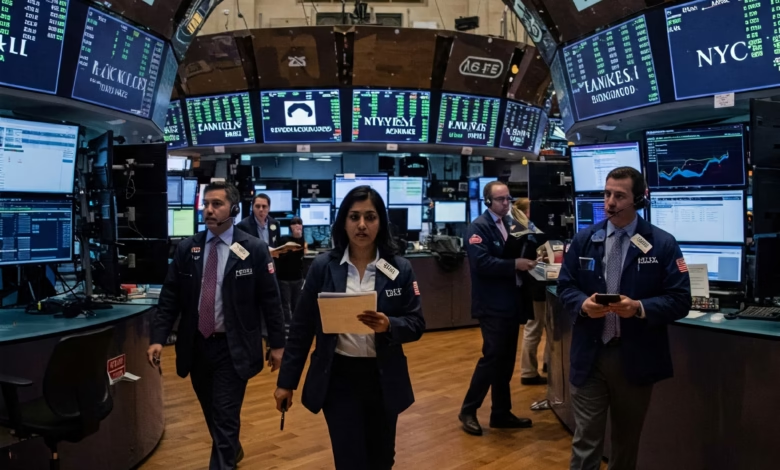How Economic Indicators Impact Stock Exchange Performance
Learn how economic indicators affect the stock market

Understanding the stock market can feel like deciphering a secret language. However, much of its movement is closely tied to the overall health of the economy. Economic indicators are key pieces of data that provide insights into the economy’s performance and future direction. For investors, keeping an eye on these indicators is crucial because they can significantly influence how the stock exchange performs. Let’s break down some of the most important economic indicators and how they can impact your investments.
GDP Growth: The Engine of Stock Market Returns

Gross Domestic Product (GDP) is the broadest measure of a country’s economic activity – the total value of goods and services produced within a specific period. Strong GDP growth generally signals a healthy and expanding economy. This often translates to:
- Increased Corporate Earnings: When the economy is doing well, businesses tend to sell more goods and services, leading to higher profits. Higher earnings can make a company’s stock more attractive to investors, driving up stock prices.
- Improved Investor Confidence: A growing economy often boosts investor sentiment. People are more optimistic about the future, leading them to invest more in the stock market.
- Job Creation: Economic growth typically leads to more job opportunities, which further fuels consumer spending and economic activity, creating a positive feedback loop for the stock market.
Conversely, slow or negative GDP growth (recession) can lead to decreased corporate earnings, lower investor confidence, and potentially a decline in stock prices.
Inflation Rates: Balancing Growth and Price Stability
Inflation measures the rate at which the general level of prices for goods and services is rising, and consequently, the purchasing power of currency is falling.1 While a moderate level of inflation can be a sign of a healthy economy, high inflation can negatively impact the stock market:
- Increased Costs for Businesses: Rising prices for raw materials, labor, and transportation can squeeze company profit margins, potentially leading to lower stock valuations.
- Higher Interest Rates: To combat high inflation, central banks like the Federal Reserve (the Fed) often raise interest rates. Higher interest rates can make borrowing more expensive for businesses and consumers, potentially slowing economic growth2 and making bonds a more attractive investment relative to stocks.
- Reduced Consumer Spending: As the cost of living increases, consumers may have less disposable income to spend on non-essential goods and services, impacting company revenues.
Low inflation or even deflation (falling prices) can also be problematic, signaling weak demand and potentially leading to lower corporate profits.
Interest Rates: The Cost of Borrowing and Investment Decisions

Interest rates, particularly the benchmark rates set by the Federal Reserve, have a significant impact on the stock market.
- Lower Interest Rates: These generally make borrowing cheaper for businesses, encouraging investment and expansion. Lower rates also reduce the attractiveness of bonds compared to stocks, potentially driving more investment into the equity market.
- Higher Interest Rates: As mentioned earlier, higher rates can increase borrowing costs, potentially slowing economic growth. They can also make bonds more appealing to investors seeking lower-risk options, potentially leading to a shift away from stocks.
The market closely watches the Fed’s decisions and statements regarding interest rate policy, as these can have immediate and substantial effects on stock prices.
Employment Data: A Reflection of Economic Health
Employment data, including the unemployment rate, job creation numbers, and labor force participation rate, provides a crucial snapshot of the economy’s health.
- Strong Job Growth and Low Unemployment: These typically indicate a healthy economy with strong consumer spending and business activity, which can be positive for the stock market. More people working means more income and more potential spending.
- High Unemployment: Conversely, a high unemployment rate suggests a weak economy with lower consumer spending and potential difficulties for businesses, often leading to negative sentiment in the stock market.
Consumer Confidence: Driving Spending and Market Sentiment

Consumer confidence indices measure how optimistic or pessimistic consumers are about the current and future state of the economy.
- High Consumer Confidence: When consumers feel confident about their financial situation and the economy’s prospects, they are more likely to spend money. This increased spending can boost corporate revenues and profits, generally supporting higher stock prices.
- Low Consumer Confidence: Conversely, low consumer confidence can lead to reduced spending, impacting company earnings negatively and potentially causing a downturn in the stock market.
Various surveys, such as the Consumer Confidence Index and the University of Michigan Consumer Sentiment Index, provide insights into this important indicator.
The Interconnectedness of Economic Indicators
It’s important to remember that these economic indicators don’t operate in isolation. They are interconnected and can influence each other. For example, strong GDP growth can lead to lower unemployment and potentially higher inflation. The Federal Reserve might then respond to rising inflation by increasing interest rates, which could, in turn, impact GDP growth and consumer confidence.
How Investors Can Use Economic Indicators

While predicting the stock market with certainty is impossible, understanding how economic indicators generally influence its performance can help investors:
- Make More Informed Decisions: By considering the direction of key economic indicators, investors can better assess the overall economic environment and potential risks and opportunities in the stock market.
- Understand Market Volatility: News about significant shifts in economic indicators can often lead to market volatility as investors adjust their expectations and positions.
- Develop a Long-Term Perspective: Economic cycles have historically influenced stock market trends. Understanding these cycles can help investors maintain a long-term perspective and avoid making rash decisions based on short-term fluctuations.
Staying Informed for Smarter Investing
Keeping track of key economic indicators is an essential part of being a well-informed investor. While the relationship between these indicators and the stock market isn’t always direct or immediate, understanding these fundamental connections can provide valuable context for your investment decisions and help you navigate the dynamic world of finance with greater confidence.





